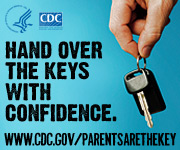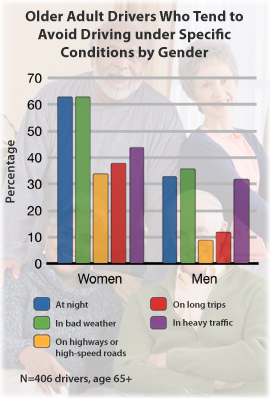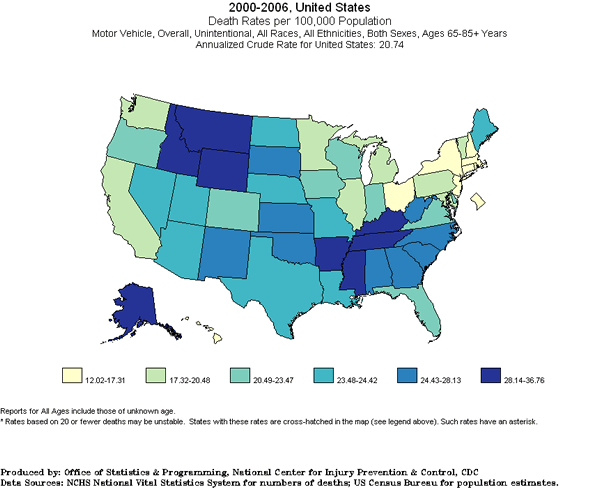Older Adult Drivers Data & Statistics
On this Page
Driving helps older adults stay mobile and independent. But the risk of being injured or killed in a motor vehicle crash increases as you age. An average of 500 older adults are injured every day in crashes.1
Thankfully, there are steps that older adults can take to stay safer on the roads.
Older Adult Driver Statistics
- In 2008, more than 5,500 older adults were killed and more than 183,000 were injured in motor vehicle crashes. This amounts to 15 older adults killed and 500 injured in crashes on average every day.1
- There were 33 million licensed older drivers in 2009, which is a 23 percent increase from 1999.2,3
- Per mile traveled, fatal crash rates increase starting at age 75 and increase notably after age 80. This is largely due to increased susceptibility to injury and medical complications among older drivers rather than an increased tendency to get into crashes.4
- Age-related declines in vision and cognitive functioning (ability to reason and remember), as well as physical changes, may affect some older adults' driving abilities.5
- Across all age groups, males had substantially higher death rates than females.4
Additional Data Sources
Web-based Injury Statistics Query and Reporting System (WISQARS)
www.cdc.gov/injury/wisqars
WISQARSTM (Web-based Injury Statistics Query and Reporting System) is an interactive database system that provides customized reports of injury-related data.
Behavioral Risk Factor Surveillance System (BRFSS)
www.cdc.gov/brfss/
The Behavioral Risk Factor Surveillance System (BRFSS) is the world’s largest, on-going telephone health survey system, tracking health conditions and risk behaviors in the United States yearly since 1984. Currently, data are collected monthly in all 50 states, the District of Columbia, Puerto Rico, the U.S. Virgin Islands, and Guam.
CDC WONDER (Wide-ranging Online Data for Epidemiologic Research )
http://wonder.cdc.gov
WONDER an easy-to-use, menu-driven system that makes the information resources of the Centers for Disease Control and Prevention (CDC) available to public health professionals and the public at large. It provides access to a wide array of public health information.
CDC Data & Statistics
www.cdc.gov/DataStatistics
The CDC Data & Statistics web site features interactive tools, surveys, publications, databases, and more.
References
- National Highway Traffic Safety Administration, Department of Transportation (US). Traffic Safety Facts 2008: Older Population. Washington (DC): NHTSA; 2009 [cited 2011 Feb 25]. Available from URL: http://www-nrd.nhtsa.dot.gov/Pubs/811161.pdf
- Federal Highway Administration, Department of Transportation (US). Highway Statistics 1999. Washington (DC): FHWA. [cited 2011 Feb 25]. Available from URL: http://www.fhwa.dot.gov/ohim/hs99/tables/dl20.pdf
- Federal Highway Administration, Department of Transportation (US). Highway Statistics 2009. Washington (DC): FHWA. [cited 2011 Feb 25]. Available from URL: http://www.fhwa.dot.gov/policyinformation/statistics/2009/dl22.cfm
- Insurance Institute for Highway Safety (IIHS). Fatality facts 2009, Older people. Arlington (VA): IIHS; 2010. [cited 2011 Feb 25]. Available from URL: http://www.iihs.org/research/fatality_facts_2009/olderpeople.html
- Owsley C. Driver Capabilities in Transportation in an Aging Society: A Decade of Experience. Technical Papers and Reports from a Conference: Bethesda, MD; Nov. 7–9, 1999. Washington, DC, Transportation Research Board; 2004.
Get email updates
To receive email updates about this page, enter your email address:
Contact Us:
- Centers for Disease Control and Prevention
National Center for Injury Prevention and Control (NCIPC)
4770 Buford Hwy, NE
MS F-63
Atlanta, GA 30341-3717 - 800-CDC-INFO
(800-232-4636)
TTY: (888) 232-6348
New Hours of Operation:
8am-8pm ET/
Monday-Friday
Closed Holidays - cdcinfo@cdc.gov






